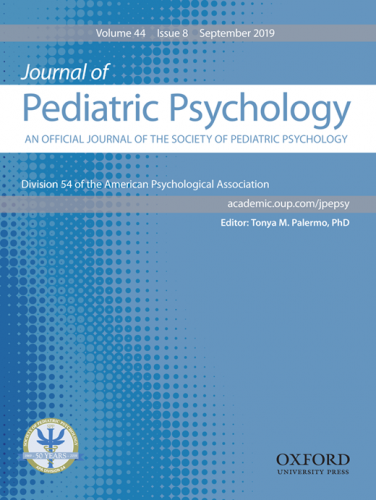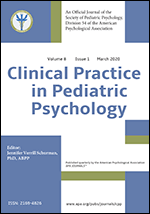Assessment Resource Sheet : Stress and Coping
Measures of stress and coping assessment tools designed to measure: (1) self-reported stress, (2) self-reported coping with general or varied specific stressors, (3) self-reported coping with pain and (4) observations of behavior for coping with pain. This list of evidence-based measures was originally published in the Journal of Pediatric Psychology (Blount et al., 2008). All measures are classified as well-established assessment, approaching well-established assessment, and promising assessment. Additional classification, as described in the article, included well-established assessment that broadens understanding or that guides treatment. Criteria for each of these classifications are included in the paper by Blount et al. (2008). Information on where to obtain the measure is included in parentheses after the name of each measure. Age ranges (when available) are included in parentheses. Central references are included after each table (and are cited with superscripts in the tables).
The measures included in this review were originally selected based on a survey in which SPP members endorsed the measures of stress and coping they had used. More frequently endorsed measures were included.
Self-Report Measures of Stress
|
Assessments |
Well-established |
Approaching |
Promising |
|
Children’s Hassles Scale and Children’s Uplifts Scale1-3 (ages 8-17) |
X |
||
|
Coddington Life Events Scale4 (ages: parent rept < 5 yrs; child rept 6-11; adol rept, 12-19) |
X |
||
|
Questionnaire on Resources and Stress5, 6 (adult, 6th grade reading level required) |
X |
Self-Report Measures of Coping - General Coping
|
Assessments |
Well-established |
Approaching |
Promising |
|
Adolescent Coping Orientation for Problem Experiences (A-Cope)7, 8 (ages 11-21, has been used with adults) |
X |
||
|
Coping Response Inventory – Youth Form9, 10 (ages 12-18) |
X |
||
|
Coping Strategies Inventory11,12 (ages 3-19, parent and child report, also used with adults) |
X |
||
|
Kidcope13 [Anthony Spirito, PhD, |
X |
||
|
Role-Play Inventory of Situations and Coping Strategies14 [Alexandra Quittner, PhD, Department of Psychology, University of Miami, 5665 Ponce de Leon Blvd., Coral Gables, FL 33146-2070], (ages: school age and adolescents, with parent report versions) |
X |
||
|
Ways of Coping Checklist15 (ages 8-adulthood) |
X |
Self-Report Measures of Coping - Pain Control
|
Assessments |
Well-established |
Approaching |
Promising |
|
Pain Coping Questionnaire-Cope16 [Graham J. Reid, PhD, |
X |
||
|
Pain Response Inventory17 [Lynn Walker, PhD, Division of Adolescent Medicine, Vanderbilt Children’s Hospital, 11128 Doctors’ Office Tower, Nashville, TN 37232-9060] (ages 8-22) |
X |
||
|
Waldron/Varni Pediatric Pain Coping Inventory oping Strategies Inventory18 [James W. Varni, PhD, Department of Landscape Architecture and Urban Planning, College of Architecture, TAMU 3137, Texas A&M University, College Station, TX 77843-3137 ](ages 5-12 and 13-18 year olds. Also, parent rept) |
X |
Observational Measures of Coping - Pain Coping
|
Assessments |
Well-established |
Approaching |
Promising |
|
Behavioral Approach-Avoicance and Distress Scale (BAADS)19, 20(ages 3-13 global rating scale) |
X |
||
|
Child-Adult Medical Procedure Interaction Scale (CAMPIS and CAMPIS-R)21-23 [Ronald L. Blount, PhD, Department of Psychology, University of Georgia, Athens, GA 30602-3013] (ages 3-13) |
X |
||
|
Child-Adult Medical Procedure Interaction Scale (CAMPIS and CAMPIS-R) 24 [Ronald L. Blount, PhD, Department of Psychology, University of Georgia, Athens, GA 30602-3013] (ages 3-13) |
X |
1. Kanner, A.D., Feldman, S.S., Weinberger, D.A., & Ford, M.E. (1987). Uplifts, hassles, and adaptational outcomes in early adolescents. Journal of Early Adolescence, 7, 371-394.
2. Kanner, A.D., Coyne, J.C., Schafer, C., & Lazarus, R.S. (1981). Comparison of two modes of
stress measurement: Daily hassles and uplifts versus major life events. Journal of Behavioral Medicine, 4, 1-39.
3. Santa Lucia, R.C., Gesten, E., Rendina-Gobioff, G., Epstein, M., Kaufmann, D., & Salcedo, O. (2000). Children’s school adjustment: a developmental transactional systems perspective. Journal of Applied Psychology, 21(4), 429-446.
4. Coddington, R.D. (1972). The significance of life events of etiologic factors in the diseases of children – I: A survey of professional workers. Journal of Psychosomatic Research, 16, 7-18.
5. Holyroyd, J. (1974). The Questionnaire on Resources and Stress: An instrument to measure family response to a handicapped family member. Journal of Community Psychology, 2, 92-94.
6. Holyroyd, J., & Guthrie, D. (1986). Family stress with chronic childhood illness: Cystic fibrosis,
neuromuscular disease and renal disease. Journal of Clinical Psychology, 42, 552-561.
7. Patterson, J.M., & McCubbin, H.I. (1987). Adolescent coping style and behaviors: Conceptualization and measurement. Journal of Adolescence, 10, 163-186.
8. McCubbin, H. I., & Thompson, A. I. (Eds.). (1991). Family assessment inventories for research and practice. Madison, WI: University of Wisconsin.
9. Ebata, A.T., & Moos, R.H. (1991). Coping and adjustment in healthy and distressed adolescents. Journal of Applied Development Psychology, 12, 33-54.
10. Moos, R.H. (1993) Coping Responses Inventory Youth Form Manual. Odessa FL: Psychological Assessment Resources.
11. Tobin, D.L., (1991). User’s manual for the Coping Strategies Inventory. Unpublished manuscript, Ohio University, Athens.
12. Tobin, D.L., Holroyd, K.A., Reynolds, R.V., & Wigal, J. K. (1989). The hierarchical factor structure of the Coping Strategies Inventory. Cognitive Therapy and Research, 13, 343-361.
13. Spirito, A., Stark, L.J., & Williams, C. (1988). Development of a brief checklist to assess coping in pediatric patients. Journal of Pediatric Psychology, 13, 555-574.
14. Quittner, A.L., Tolbert, V.E., & Regoli, M.J. (1996). Development of the role-play inventory
of situations and coping strategies for parents of children with cystic fibrosis. Journal of Pediatric Psychology, 21, 209-235.
15. Folkman, S. & Lazarus, R. S. (1980). An analysis of coping in a middle-aged community sample. Journal of Health and Social Behavior, 21, 219-239.
16. Reid, G.J., Gilbert, C.A., & McGrath, P.J. (1998). The Pain Coping Questionnaire: Preliminary validation. Pain, 76, 83-96.
17. Walker, L.S., Smith, C.A., Garber, J. & Van Slyke, D.A. (1997). Development and validation of the pain response inventory for children. Psychological Assessment, 9, 392-405.
18. Varni, J.W., Waldron, S.A., Gragg, R.A., Rapoff, M.A., Bernstein, B.H., Lindsley, C.B., Newcomb, M.D. (1996). Development of the Waldron/Varni Pediatric Pain Coping Inventory. Pain, 67(1), 141-150.
19. Hubert, N.C., Jay, S. M., Saltoun, M., & Hayes, M. (1988). Approach-avoidance and distress in children under preparation for painful medical procedures. Journal of Clinical Child Psychology, 17, 194-202.
20. Bachanas, P.J., & Blount, R.L. (1996). The Behavioral Approach – Avoidance and Distress Scale: An investigation of reliability and validity during painful medical procedures. Journal of Pediatric Psychology, 21, 671-681.
21. Blount, R. L., Corbin, S. M., Sturges, J. W., Wolfe, V. V., Prater, J. M., & James, L. D. (1989). The relationship between adults behavior and child coping and distress during BMA/LP procedures: A sequential analysis. Behavior Therapy, 20, 585-601.
22. Blount, R.L., Sturges, J.W., & Powers, S.W. (1990). Analysis of child and adult behavioral variations by phase of medical procedure. Behavior Therapy, 21, 33-48.
23. Blount, R.L., Cohen, L.L., Frank, N.C., Bachanas, P.J., Smith, A.J., Manimala, M.R., & Pate, J.T. (1997). The Child-Adult Medical Procedure Interaction Scale-Revised: An assessment of validity. Journal of Pediatric Psychology, 22, 73-88.
24. Blount, R.L., Bunke, V.L., Cohen, L.L., & Forbes, C.J. (2001). The Child-Adult Medical Procedure Interaction Scale-Short Form (CAMPIS-SF): Validation of a rating scale for children’s and adults’ behaviors during painful medical procedures. Journal of Pain and Symptom Management, 22, 591-599.



